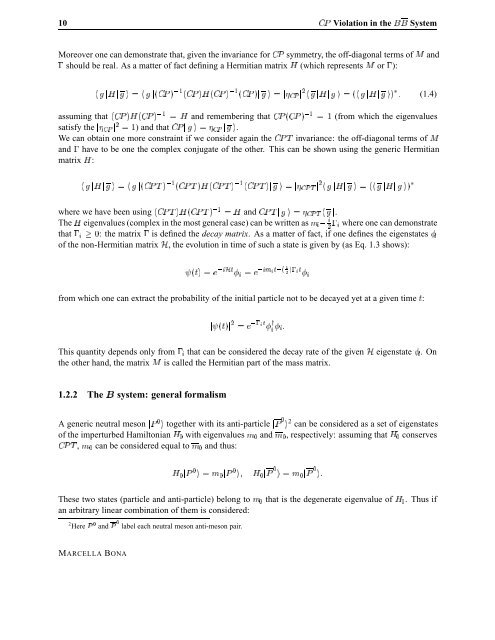Violation in Mixing
Violation in Mixing
Violation in Mixing
You also want an ePaper? Increase the reach of your titles
YUMPU automatically turns print PDFs into web optimized ePapers that Google loves.
10 �È <strong>Violation</strong> <strong>in</strong> the �� System<br />
Moreover one can demonstrate that, given the <strong>in</strong>variance for �È symmetry, the off-diagonal terms of Å and<br />
should be real. As a matter of fact def<strong>in</strong><strong>in</strong>g a Hermitian matrix À (which represents Å or ):<br />
� � �À� � � � � � � �È �È À �È �È � � � � ���È � � � �À� � � � ���À��� £ � (1.4)<br />
assum<strong>in</strong>g that �È À �È � À and remember<strong>in</strong>g that �È �È � (from which the eigenvalues<br />
satisfy the ���È � � ) and that �È � � � � ��È � � �.<br />
We can obta<strong>in</strong> one more constra<strong>in</strong>t if we consider aga<strong>in</strong> the �ÈÌ <strong>in</strong>variance: the off-diagonal terms of Å<br />
and have to be one the complex conjugate of the other. This can be shown us<strong>in</strong>g the generic Hermitian<br />
matrix À:<br />
� � �À� � � � � � � �ÈÌ �ÈÌ À �ÈÌ �ÈÌ ��� ����ÈÌ� ���À��� � ���À��� £<br />
where we have been us<strong>in</strong>g �ÈÌ À �ÈÌ � À and �ÈÌ��� � ��ÈÌ���.<br />
The À eigenvalues (complex <strong>in</strong> the most general case) can be written as Ñ� � � where one can demonstrate<br />
that � � : the matrix is def<strong>in</strong>ed the decay matrix. As a matter of fact, if one def<strong>in</strong>es the eigenstates ��<br />
of the non-Hermitian matrix À, the evolution <strong>in</strong> time of such a state is given by (as Eq. 1.3 shows):<br />
� Ø �� �ÀØ ���� �Ñ�Ø �Ø ��<br />
from which one can extract the probability of the <strong>in</strong>itial particle not to be decayed yet at a given time Ø:<br />
�� Ø � � � �Ø � Ý � ���<br />
This quantity depends only from � that can be considered the decay rate of the given À eigenstate ��. On<br />
the other hand, the matrix Å is called the Hermitian part of the mass matrix.<br />
1.2.2 The � system: general formalism<br />
A generic neutral meson �È � together with its anti-particle �È � 2 can be considered as a set of eigenstates<br />
of the imperturbed Hamiltonian À with eigenvalues Ñ and Ñ , respectively: assum<strong>in</strong>g that À conserves<br />
�ÈÌ, Ñ can be considered equal to Ñ and thus:<br />
À �È � � Ñ �È �� À �È � � Ñ �È ��<br />
These two states (particle and anti-particle) belong to Ñ that is the degenerate eigenvalue of À . Thus if<br />
an arbitrary l<strong>in</strong>ear comb<strong>in</strong>ation of them is considered:<br />
2 Here È and È label each neutral meson anti-meson pair.<br />
MARCELLA BONA















